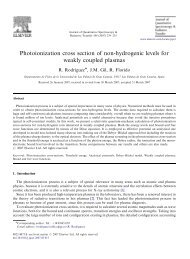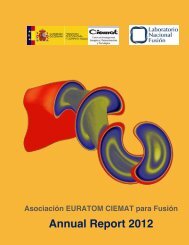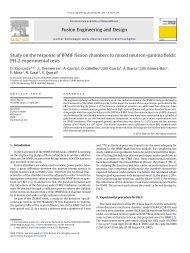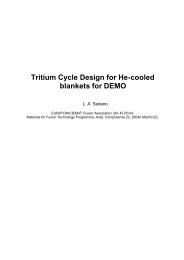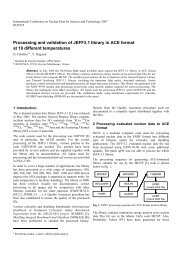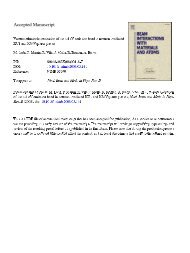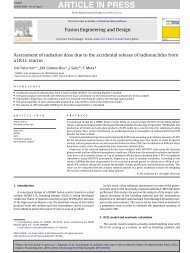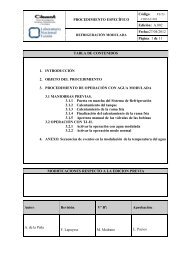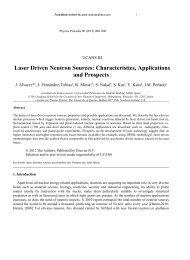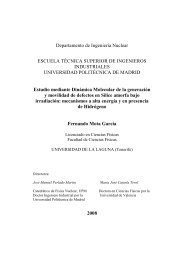RF Design of the Re-buncher Cavities for the LIPAC ... - CERN
RF Design of the Re-buncher Cavities for the LIPAC ... - CERN
RF Design of the Re-buncher Cavities for the LIPAC ... - CERN
Create successful ePaper yourself
Turn your PDF publications into a flip-book with our unique Google optimized e-Paper software.
Proceedings <strong>of</strong> IPAC2011, San Sebastián, SpainMOPC047Table 2: Comparison results <strong>of</strong> <strong>the</strong> <strong>RF</strong>re-<strong>buncher</strong> cavities studied <strong>for</strong> <strong>LIPAC</strong> (all in copper).Configuration Pillbox HWR QWR 3-GAP QWR 4-GAP QWR 4-GAP IH5-GAP IH UnitsVacuum length (beam axis) 200 240 240 280 280 280Vacuum height 860 876 507 495 495 504Total power 75 41.7 25.8 12.2 9.4 8.5Central stem power - 30.5 18 4.0 1.7 2.2Side stem power - - - - 1990 1447Q 24279 11347 10773 11413 10148 11570E peak 24.3 20 20.6 21.0 14.8 16.0Power density peak 30.3 42 97.4 17.0 13.1 12.0Shunt impedance 0.82 1.46 2.36 4.99 6.51 7.19The HWR power consumption is higher than QWRone, but <strong>the</strong> cooling system design would be easierbecause its stem geometry allows a direct cooling channelgoing across <strong>the</strong> re-<strong>buncher</strong>. Never<strong>the</strong>less, <strong>the</strong> HWR stemcomplicates <strong>the</strong> location <strong>of</strong> a vacuum port. In addition,HWR height is double than QWR one, and <strong>RF</strong> losses are50% higher.The QWR design decreases power consumptioncompared with <strong>the</strong> pillbox and HWR cavities, but someimportant issues should be taken into account: Steering effects: <strong>the</strong>re is an asymmetry in <strong>the</strong>field maps due to <strong>the</strong> drift tube position. Multipactoring inherent to coaxial resonators.In order to relax <strong>the</strong>se issues, it can be concluded that<strong>the</strong> study <strong>of</strong> coaxial resonators with increasing number <strong>of</strong>gaps is a very interesting strategy. One expects that bothpower consumption and power density can be fur<strong>the</strong>rdecreased, while <strong>the</strong> a<strong>for</strong>ementioned drawbacks do notincrease.Multi-gap resonatorsThree to five gap resonators are studied inthis section:3 and 4-gap ones are depicted in Fig. 2, while <strong>the</strong> five gapone is shown in Fig. 3. A significant decrease <strong>of</strong> <strong>RF</strong>losses and peak electric field is achieved with eachadditional gap. The available length is too small toallocate a 5-gap cavity, but due to <strong>the</strong> significant benefits,<strong>the</strong> MEBT layout has been changed, ncreasing thatlength up to 350 mm. The stem cooling is much easier in<strong>the</strong> 5-gap design, which clearly compensates <strong>the</strong> higherfabrication cost.Figure 2: 3 and 4 gap resonators: 3-gap QWR(left), 4-gapQWR (middle), and 4-gap IH (right).07 Accelerator TechnologyOn <strong>the</strong> o<strong>the</strong>r side, <strong>RF</strong> per<strong>for</strong>mancee (shunt impedance)<strong>of</strong> IH type is better than QWR one. The de<strong>for</strong>mationunder atmospheric pressure will behigher in <strong>the</strong> IHmodel, but acceptable with steel endplates.Multipactoring will happen mainly in regular orsymmetric geometries, <strong>the</strong>re<strong>for</strong>e QWR will be moreprone to problems. Finally, an additional advantage isenvisaged, as due to <strong>the</strong> lower required power, bothcooling system and <strong>RF</strong> source requirements are relaxed.In short, it is reasonable to choose <strong>the</strong> 5-gap IH cavityas <strong>the</strong> best candidate <strong>for</strong> <strong>LIPAC</strong> re<strong>buncher</strong>s.DETAILED DESIGThe next step is <strong>the</strong> detailed design <strong>of</strong> <strong>the</strong> 5-gap IHcavity. A full model, including <strong>the</strong> fillet radii necessary<strong>for</strong> <strong>the</strong> fabrication (milling tools) and<strong>the</strong> recesses <strong>for</strong> <strong>the</strong>stem bases, has been studied. Two CF100 pumping portsare drilled on <strong>the</strong> side wall.High order modesFigure 3: 5-gaps IH cavity.320 mm460 mm6.6 kW1.2 kW678 W11746 --13.9 MV/m8.9 W/cm29.29 MΩPerturbations due to high orderr modes in a lowfrequency linac are usually moderate. However, due to<strong>the</strong> high beam power, <strong>the</strong> allowed beam losses are verysmall, and high order modes have been analysed. Table 3T06 Room Temperature <strong>RF</strong> 185Copyright c○ 2011 by IPAC’11/EPS-AG — cc Creative Commons Attribution 3.0 (CC BY 3.0)



